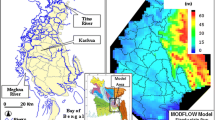Abstract
The paper aims at evaluating the interaction between ground and surface water along the Langat River in Malaysia through the development of a numerical simulation. Malaysia has been experiencing a rapid economic growth since the last few decades, driven by many factors such as agriculture, industry, and the like. The demand for water in these sectors has increased so tremendously that surface water has been utilized in conjunction to groundwater. Approximately 18,184 m3 of water per day is obtained from the aquifer to supply to the steel factory. There are also workshops, petroleum stations, and houses in the area thus causing the water quantity and quality to degrade. In terms of quantity, the pumping activity has altered the interaction between the groundwater and surface water. Therefore, a numerical model was proposed and two aquifer layers were simulated, with the first layer being approximately >20 m in depth and the second layer >100 m. The recharge estimated from the tank model was input into the groundwater modeling. The effects of the surface water to the aquifer were included in the simulation by defining the river conductance, river bed, and river level. The calibrated model (error about 0.9 m) was achieved and applied to predict the flow pattern in its natural state without the pumping and with the pumping states. As a result, in the first scenario, the stream was in an effluent condition influenced by the groundwater from the northeast to the west. A hyporheic flow occurred and was observed from the contour map. The flow system was changed in the second scenario when the pumping activity was included in the simulation. The groundwater lost its original function but received leakage from the stream near the pumping sites. The findings of this study will help the local authorities and other researchers to understand the aquifer system in the area and assist in the preparation of a sustainable groundwater management.











Similar content being viewed by others
References
Aqil M, Kita I, Yano A, Nishiyama S (2007) Analysis and prediction of flow from local source in a river basin using a Neuro-fuzzy modeling tool. J Environ Manag 85(1):215–223
Bencala KE (2005) Hyporheic exchange flow. United States Geological Survey
Damien L, Bayarni C, Gareth O, David S (2010) Hyporheic handbook: Chapter 3: Geomorphology and sediments of the hyporheic zone
Department of Environment (DOE) (2006) Environmental quality report. Ministry of Natural Resources and Environment, Malaysia
Department of Irrigation and Drainage (DID) (2012) Online hydrological data. http://infobanjir.water.gov.my/ve/vmapsel.cfm. Cited 24 April 2012
Duque C, López-Chicano M, Calvache ML, Martín-Rosales W, Gómez-Fontalva JM, Crespo F (2011) Recharge sources and hydrogeological effects of irrigation and an influent river identified by stable isotopes in the Motril-Salobreña aquifer (Southern Spain). Hydrol Process 25(14):2261–2274
Fetter CW (2001) Applied hydrogeology, 4th edn. Prentice Hall, New Jersey, p 128
Japan International Cooperation Agency (JICA) and Minerals and Geoscience Department Malaysia (MGDM) (2002) The study on the sustainable groundwater resources and environmental management for the Langat Basin in Malaysia, vol. 1–5
Smith JWN (2005) Groundwater–surface water interactions in the hyporheic zone. Environment Agency, Science Report SC030155/SR1
Tsutsumi A, Jinno K, Berndtsson R (2004) Surface and subsurface water balance estimation by the groundwater recharge model and a 3-D two-phase flow model. Hydrol Sci 49(2):205–226
United States Geological Survey (USGS) (2012) Natural processes of ground-water and surface-water interaction. http://pubs.usgs.gov/circ/circ1139/htdocs/natural_processes_of_ground.htm. Accessed 24 Apr 2012
Acknowledgments
The authors gratefully acknowledge the financial support of the Fundamental Research Grant Scheme [600-RMI/FRGS 5/3 (32/2012)] of the Ministry of Higher Education (MOHE), Malaysia. The Department of Minerals and Geoscience (JMG), Selangor, Malaysia is acknowledged for the secondary data and assistance during the site investigations. The Department of Irrigation and Drainage (DID) Malaysia is acknowledged for the hydrological data. The authors would like to thank the anonymous reviewer for his constructive comments that greatly contributed to improving the quality of the paper. They would also like to thank the Editors for their generous comments and support during the review process. The authors gratefully acknowledge the constructive comments and suggestions from Prof. Dr. Kenji JINNO, the former head of the Urban and Environmental Engineering Department, Graduate School of Engineering, Kyushu University, Japan. Last but not least, the environmental laboratory assistants at the Faculty of Civil Engineering, Universiti Teknologi MARA (UiTM), are also thanked for their valuable assistance.
Author information
Authors and Affiliations
Corresponding author
Rights and permissions
About this article
Cite this article
May, R., Mazlan, N.S.B. Numerical simulation of the effect of heavy groundwater abstraction on groundwater–surface water interaction in Langat Basin, Selangor, Malaysia. Environ Earth Sci 71, 1239–1248 (2014). https://doi.org/10.1007/s12665-013-2527-4
Received:
Accepted:
Published:
Issue Date:
DOI: https://doi.org/10.1007/s12665-013-2527-4




